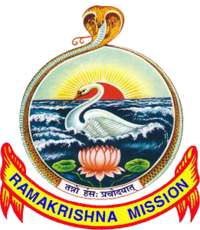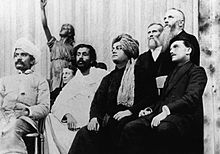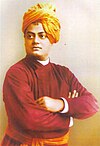Ramakrishna Mission
 | |
| Abbreviation | RKM |
|---|---|
| Formation | 1 May 1897 Calcutta, Bengal Presidency, British India (present-day Kolkata, West Bengal, India) |
| Founder | Swami Vivekananda |
| Type | Religious organisation |
| Legal status | Foundation |
| Purpose | Educational, philanthropic, religious studies, spirituality |
| Headquarters | Belur Math, West Bengal, India |
| Location | |
| Coordinates | 22°22′N 88°13′E / 22.37°N 88.21°E |
Area served | Worldwide |
| Swami Gautamananda | |
| Affiliations | Advaita Vedanta (Hinduism) |
| Website | belurmath |
| Part of a series on |
| Advaita |
|---|
 |
|
|
| Part of a series on |
| Hinduism |
|---|
 |
Ramakrishna Math and Ramakrishna Mission (RKM) is a spiritual and philanthropic organisation headquartered in Belur Math, West Bengal.[1][2] The mission is named after the Indian Hindu spiritual guru and mystic Ramakrishna.[1] The mission was founded by Ramakrishna's chief disciple Swami Vivekananda on 1 May 1897.[1] The organisation mainly propagates the Hindu philosophy of Vedanta–Advaita Vedanta and four yogic ideals – Jnana, Bhakti, Karma, and Raja yoga.[3][1] The mission bases its work on the principles of Karma Yoga, the principle of selfless work done with a dedication to God.[1]
Overview
[edit]

The Math and the Mission are the two key organizations that direct the work of the Ramakrishna movement. The Ramakrishna Math, alternatively referred to as the Ramakrishna Order, is a monastic institution associated with the religious movement established by Ramakrishna in 1886. The primary emphasis of the Math lies in the cultivation of spiritual development and the dissemination of the movement's doctrines.[4]
The Mission, founded by Vivekananda in 1897,[5] is a humanitarian organisation that carries out medical, relief, and educational programs. Both organisations have headquarters at Belur Math.[4]
The Mission acquired legal status when it was registered in 1909 under Act XXI of 1860. Its management is vested in a Governing Body. Though the Mission with its branches is a distinct legal entity, it is closely related to the Math.
The elected trustees of the Math also serve as the Mission's Governing Body.[4]
History
[edit]

Ramakrishna Paramahamsa (1836–1886), regarded as a 19th-century mystic, was the inspirer of the Ramakrishna Order of monks[6] and is regarded as the spiritual founder of the Ramakrishna Movement.[7][8] Ramakrishna was a priest at the Dakshineswar Kali Temple and attracted several monastic and household disciples.
In 1886, shortly before his death, Ramakrishna gave the ochre cloths of renunciation to his young disciples, who were planning to become renunciants. Ramakrishna entrusted the care of these young aspirants to Vivekananda. After his death, the young disciples of Ramakrishna gathered and practised spiritual disciplines. They took informal monastic vows on the night of 24 December 1886.[6]
After the death of Ramakrishna in 1886, the monastic disciples formed the first Math (monastery) at Baranagore. Later, Vivekananda became a wandering monk, and in 1893, he was a delegate at the Parliament of the World's Religions held in the year 1893. His speech there, beginning with "Sisters and Brothers of America," became famous and brought him widespread recognition. Vivekananda went on lecture tours and held private discourses on Hinduism and spirituality. He also founded the first Vedanta Society in the United States, in New York. He returned to India in 1897 and founded the Ramakrishna Mission on 1 May 1897.[6] Though he was a Hindu sadhu and was hailed as the first Hindu missionary in modern times, he exhorted his followers to be true to their faith and respect all the religions of the world, as his guru Ramakrishna had taught that all religions are pathways to God. One such example is his exhortation that one can be born in a church, but he or she should not die in a church, meaning that one should realise the spiritual truths for themselves and not stop at blindly believing in doctrines taught to them. The same year, famine relief was started at Sargachi by Swami Akhandananda, a direct disciple of Ramakrishna. Swami Brahmananda, a direct disciple of Ramakrishna, was appointed as the first president of the Order. After the death of Vivekananda in 1902, Sarada Devi, the spiritual counterpart of Ramakrishna, played an important role as the advisory head of a nascent monastic organisation. Gayatri Spivak writes that Sarada Devi "performed her role with tact and wisdom, always remaining in the background."[9]
Administration
[edit]The Board of Trustees holds all the authority inside the twin organisation, Ramakrishna Math and Mission. The governing body known as the Board of Trustees consists of several key positions, including an elected President, one or more vice presidents, a General Secretary, one or more Assistant General Secretaries, and a Treasurer.[10]
The individual holding the position of President serves as the highest authority within both Ramakrishna Math and Ramakrishna Mission, overseeing all affiliated branch centres and the central headquarters located at Belur Math.[10][11]
The composition of the Board of Trustees comprises elected members of the Ramakrishna Order who hold senior positions as monks. The appointment of a head is done by the Trustees, who designate the head of a branch centre of Ramakrishna Math.[10]
The Ramakrishna Movement comprises four distinct streams. The inclusion of ordinary devotees assuming the role of monks within the Ramakrishna Math constitutes the initial manifestation of the movement. The second stream consists of lay devotees who choose not to renounce the world but instead engage in voluntary activities. The third stream is Sarada Math and the Ramakrishna Sarada Mission. The fourth branch is the "Private Ashramas," which operate autonomously and are not administratively affiliated with the Ramakrishna Math and Ramakrishna Mission.[12]
Motto and principles
[edit]The aims and ideals of the Mission are purely spiritual and humanitarian, and they have no connection with politics.[13] The mission strives to practice and preach these.[14] The Principles of the Upanishads and Yoga in the Bhagavad Gita are reinterpreted in light of Ramakrishna's life and teachings, and are the main source of inspiration for the Mission.[15]
Motto
[edit]Manifestation of the Atman can be realized through any of the four yogas. The Ramakrishna Mission also believes in the harmony of all religions, i.e. that all religions lead to the same goal if followed properly.[16]
Monastic Order
[edit]After the death of Ramakrishna in 1886, his young disciples organised themselves into a new monastic order. The original monastery at Baranagar, known as Baranagar Math, was subsequently moved to the nearby Alambazar area in 1892, then to Nilambar Mukherjee's Garden House, south of the present Belur Math in 1898 before finally being shifted in January 1899 to a newly acquired plot of land at Belur in Howrah district by Vivekananda.[17]
Attitude towards politics
[edit]Almost 95% of the monks possess voter ID cards for the sake of identification and particularly for traveling, as they are forced by governmental authorities to seek a voter ID card. But they generally use it only for identification purpose and not for voting though they are not forbidden to vote. As individuals, the monks may have political opinions, but these are not meant to be discussed in public.[18][19]
The Mission, had, however, supported the movement of Indian independence, with a section of the monks keeping close apolitical relations with freedom fighters of various camps. A number of political revolutionaries later joined the Ramakrishna Order.[20]
Indira Gandhi's association
[edit]Former Prime Minister Indira Gandhi and her mother went to the Belur Math headquarters of the Ramakrishna Mission where Swami Ranganathananda was her guardian.[21]
Narendra Modi's association
[edit]In interviews, current Prime Minister Narendra Modi has described visiting Hindu ashrams founded by Swami Vivekananda: the Belur Math near Kolkata, the Advaita Ashrama in Almora and the Ramakrishna Mission in Rajkot. His stays at each ashram were brief because he lacked the required college education.[22] Vivekananda has had a large influence in Modi's life.[23]
Emblem
[edit]Designed and explained by Swami Vivekananda in his own words:[24]
- The wavy waters in the picture are symbolic of Karma; the lotus, of Bhakti; and the rising-sun, of Jnana. The encircling serpent is indicative of [Raja] Yoga and the awakened Kundalini Shakti, while the swan in the picture stands for Paramatman (Supreme Self). Therefore, the idea of the picture is that by the union of Karma, Jnana, Bhakti and Yoga, the vision of Paramatman is obtained.
Activities
[edit]
 Social service and health promotion at the Home of Service – Ramakrishna Mission, Varanasi, India
Social service and health promotion at the Home of Service – Ramakrishna Mission, Varanasi, India
The principal workers of the mission are the monks. The mission's activities cover the following areas:[14]
- Education[25]
- Healthcare
- Cultural activities
- Rural upliftment
- Tribal welfare
- Youth movement, spiritual teachings
The mission has its own hospitals, charitable dispensaries, maternity clinics, tuberculosis clinics, and mobile dispensaries. It also maintains training centres for nurses. Orphanages and homes for the elderly are included in the mission's field of activities, along with rural and tribal welfare work.[26]
The mission has established many renowned educational institutions in India, having its own university, colleges, vocational training centres, high schools and primary schools, teacher-training institutes, as well as schools for the visually handicapped.[26] It has also been involved in disaster relief operations during famine, epidemic, fire, flood, earthquake, cyclone and communal disturbances.[26]
The mission played an important role in the installation of photovoltaic (PV) lighting systems in the Sundarbans region of West Bengal. Due to the geographical features of the Sunderbans, it is very difficult to extend the grid network to supply power to its population. The PV lighting was used to provide electricity to the people who were traditionally depending on kerosene and diesel.[27]
Religious activities
[edit]The mission is a non-sectarian organisation[28][full citation needed][29] and ignores caste distinctions.[30]
Ramakrishna ashrama's religious activities include satsang and arati. Satsang includes communal prayers, songs, rituals, discourses, reading and meditation. Arati involves the ceremonial waving of lights before the images of a deity of holy person and is performed twice in a day.[31] Their ashramas observes major Hindu festivals, including Maha Shivarathri, Rama Navami, Krishna Ashtami and Durga Puja. They also give special place to the birthdays of Ramakrishna, Sarada Devi, Swami Vivekananda and his other monastic disciples.[31] 1 January is celebrated as Kalpataru Day.[32]
The math and the mission are known for their religious tolerance and respect for other religions. Among the earliest rules laid down by Swami Vivekananda for them was, "Due respect and reverence should be paid to all religions, all preachers, and to the deities worshiped in all religions."[33] Acceptance and toleration of all religions is the one of ideals of Ramakrishna Math and Mission. Along with the major Hindu festivals, Christmas Eve and Buddha's birthday are also devoutly observed.[31][33][34] Cyril Veliath a Jesuit of Sophia University writes that the Mission monks are a relatively orthodox set of monks who are "extremely well respected both in India and abroad", and that they "cannot be classified as just another sect or cult, such as the groups led by the gurus". Veliath writes that "of the Hindu groups I have worked with I have found the Ramakrishna Mission to be the most tolerant and amenable to dialogue, and I believe that we Christians couldn't do better, than to cooperate wholeheartedly in their efforts towards inter-religious harmony.[35][36]
Awards and honours
[edit]



The Ramakrishna Mission has received numerous accolades throughout its lifetime:
- Bhagwan Mahavir Foundation Award (1996).[37]
- Dr. Ambedkar National Award (1996).[37]
- Dr. Bhawar Singh Porte Tribal Service Award (1997–98).[37]
- In 1998 the Mission was awarded the Indian government's prestigious Gandhi Peace Prize.[38][39][40]
- Shahid Vir Narayan Singh Award (2001).[37]
- Pt. Ravishankar Shukla Award (2002).[37]
- National Communal Harmony Award (2005).[41]
- The Ramakrishna Mission was selected for an honorary mention of the UNESCO Madanjeet Singh Prize for Promotion of Tolerance and Non violence 2002.[42]
- The Ramakrishna Mission Ashrama Narainpur, Chhattisgarh was jointly selected for the 25th Indira Gandhi Award for National Integration for the year 2009 with musician A.R.Rehman for their services in promoting and preserving national integration.[43][44]
In a speech made in 1993, Federico Mayor, Director-General of UNESCO, stated:[45]
I am indeed struck by the similarity of the constitution of the Ramakrishna Mission which Vivekananda established as early as 1897 with that of UNESCO drawn up in 1945. Both place the human being at the center of their efforts aimed at development. Both place tolerance at the top of the agenda for building peace and democracy. Both recognize the variety of human cultures and societies as an essential aspect of the common heritage.
Branch centres
[edit]
As of March 7, 2022, the Math and Mission have 261 centres all over the world: 198 in India, 26 in Bangladesh, 14 in the United States, two each in Canada, Russia, and South Africa and one each in Argentina, Australia, Brazil, Fiji, France, Germany, Ireland, Japan, Malaysia, Mauritius, Nepal, Netherlands, Singapore, Sri Lanka, Switzerland, the UK, and Zambia. Besides, there are 44 sub-centres (14 within India, 30 outside India) under different centres.[46][47]
The centres of the Ramakrishna Order outside India fall into two broad categories. In countries such as Bangladesh, Nepal, Sri Lanka, Fiji and Mauritius, the nature of service activities is very similar to India. In other parts of the world, especially in Europe, Canada, the United States, Japan, and Australia, the work is mostly confined to the preaching of Vedanta, the publication of books and journals and personal guidance in spiritual matters.[48] Many of the centres outside India are called as the 'Vedanta Society' or 'Vedanta Centre'.
Controversies
[edit]In 1980, in an act that caused "considerable debate" within the order, the mission petitioned the courts to have their organisation and movement declared a non-Hindu minority religion for the purpose of Article 30 of the Indian constitution.[49][50]
Many generations of monks and others have been of the view that the religion propounded and practised by Ramakrishna and his disciples was different from that practised by the Hindu masses then. They held that Ramakrishna's "Neo-Vedanta" is a truer version of the ideals of Vedanta. So it was honestly felt that this makes the followers of Ramakrishna eligible for the legal status of "minority". It is possible that the immediate cause for the appeal for minority status was the danger that the local Marxist government would take control of its educational institutions unless it could invoke the extra protection the Indian constitution accords to minority religions.[50][51]
While the Calcutta High Court accepted the Mission's pleas, the Supreme Court of India ruled against it in 1995, citing evidence that it had all the characteristics of a Hindu organization.[52] The Mission found it advisable to let the matter rest. The wisdom of the attempt by the Mission's leadership to characterize the Mission as non-Hindu was widely questioned within the membership of the organization itself, and the leadership today embraces the Mission's status as both a Hindu organization and as an organization that emphasizes the harmony of all faiths.[53]
See also
[edit]- List of publications by Ramakrishna Mission
- List of Ramakrishna Mission institutions
- New religious movement
- RKM Football Academy
References
[edit]- ^ a b c d e "The Ramakrishna Movement". Centre Védantique Ramakrishna. 26 November 2011. Archived from the original on 2 July 2017. Retrieved 14 January 2018.
- ^ "Ramakrishna Movement". Ramakrishna Vedanta Society of North Carolina. 15 July 2017. Retrieved 14 January 2018.
- ^ "Ideology". Belur Math: The Headquarters of Ramakrishna Math & Ramakrishna Mission. Retrieved 25 July 2017.
- ^ a b c Carl T. Jackson. "Preface". Vedanta for West. pp. xii–xiii.
- ^ Jeffery D. Long, Historical Dictionary of Hinduism, p.247
- ^ a b c Vrajaprana, Pravrajika (1994). Living wisdom: Vedanta in the West. Vedanta Press. pp. 34–36. ISBN 978-0-87481-055-4.
- ^ Carl T. Jackson, Vedanta for the West p.16
- ^ Sharma, Arvind (1988). Neo-Hindu views of Christianity. Brill Publishers. p. 69. ISBN 978-90-04-08791-0.
- ^ Spivak, Gayatri Chakravorty (2007). Other Asias. Wiley-Blackwell. p. 207.
- ^ a b c donationsbm. "Board of Trustees". Belur Math – Ramakrishna Math and Ramakrishna Mission. Retrieved 28 July 2023.
- ^ donationsbm. "The President of Ramakrishna Math and Ramakrishna Mission". Belur Math – Ramakrishna Math and Ramakrishna Mission. Retrieved 28 July 2023.
- ^ "Ramakrishna Movement". Vedanta Center of North Carolina. Retrieved 28 July 2023.
- ^ The social role of the Gita: how and why, p.77, p.80
- ^ a b The social role of the Gita: how and why, p.83
- ^ The social role of the Gita: how and why, pp.8–9
- ^ donationsbm. "Ideology". Belur Math – Ramakrishna Math and Ramakrishna Mission. Retrieved 3 June 2021.
- ^ "History of Belur Math". SriRamakrishna.org. Archived from the original on 13 September 2008.
- ^ "Lok Sabha Elections: Monks of Ramakrishna Mission to abstain from voting". DNA India. 29 April 2014. Retrieved 22 July 2020.
- ^ "Monks of Ramakrishna Mission to abstain from voting". The Economic Times. 29 April 2014. ISSN 0013-0389. Retrieved 20 June 2023.
- ^ PTI (29 April 2014). "We use voter ID card for identification, not voting". The Hindu Business Line. Retrieved 14 January 2018.
- ^ Dommermuth-Costa, Carol (2002). Indira Gandhi : daughter of India. Minneapolis: Lerner Publications Co. pp. 42–43, 45. ISBN 9780822549635.
- ^ * Marino 2014, pp. 30–33
- Mukhopadhyay 2013, pp. 128–129
- "Narendra Modi invited to Ramakrishna Mission's headquarter in Belurmath". The Economic Times. 26 May 2014. Archived from the original on 31 October 2014. Retrieved 17 October 2014.
- ^ "The tale of two Narendras: Narendra Modi and Swami Vivekananda". The Statesman. 4 July 2016. Archived from the original on 18 February 2017. Retrieved 18 February 2017.
- ^ Vivekananda, Swami. "Conversations And Dialogues ~ XVI". The Complete Works of Swami Vivekananda. Vol. 7. Advaita Ashrama.
- ^ "Ramakrishna Mission in the Field of Education — Ramakrishna Mission Saradapitha, Belur". belurmath.org. Belur Math Educational Services. Archived from the original on 6 August 2022. Retrieved 6 August 2022.
- ^ a b c Vrajaprana, Pravrajika (1994). "Editor's note on Introduction". Living Wisdom: Vedanta in the West. pp. 36–37.
- ^ Stone, J.L.; Ullal, H.S.; Chaurey, A.; Bhatia, P. (2000). "Ramakrishna Mission initiative impact study-a rural electrification project in West Bengal, India". Conference Record of the Twenty-Eighth IEEE Photovoltaic Specialists Conference - 2000 (Cat. No.00CH37036). Anchorage, AK, USA: IEEE. pp. 1571–1574. doi:10.1109/PVSC.2000.916197. ISBN 978-0-7803-5772-3. S2CID 118203518.
- ^ Contributions to Indian Sociology. 16. Mouton: 127. 1982. ISSN 0069-9659.
{{cite journal}}: Missing or empty|title=(help)[full citation needed] - ^ Klostermaier, Klaus K. (2000). Hinduism: a short history. Oneworld. p. 271. ISBN 9781851682133.
- ^ Oxtoby, Willard Gurdon (1996). World religions: Eastern traditions. Oxford University Press. p. 77.
- ^ a b c Prozesky, Martin; John De Gruchy (1995). "Hinduism". Living faiths in South Africa. C. Hurst & Co. Publishers. pp. 195–196. ISBN 978-1-85065-244-1.
- ^ Balakrishnan, S (31 December 2001). "The spiritual significance". The Hindu. Archived from the original on 28 October 2003. Retrieved 1 October 2009.
- ^ a b Jung, Moses; Herbert W. Schnieder (1963). "Hinduism". Relations among Religions today. Brill Publishers. pp. 69–70.
- ^ Ananda (2 April 2009). "Service in the name of God in every human". The Telegraph. Archived from the original on 13 September 2012. Retrieved 25 August 2009.
- ^ Veliath, Cyril (Summer 2004). "Hinduism in Japan". Inter-Religio. 45. Nanzan Institute for Religion and Culture (NIRC): 21–29.
- ^ Robinson, Bob (2004). "Ramakrishna and Vivekananda". Christians Meeting Hindus: An Analysis and Theological Critique of the Hindu-Christian Encounter in India. OCMS. pp. 7–8. ISBN 978-1-870345-39-2. OCLC 55970669.
- ^ a b c d e "Achievements". Archived from the original on 15 April 2013. Retrieved 24 October 2008.
- ^ Wilcockson, Michael (2003). A Student's Guide to A2 Religious Studies for the OCR Specification. Rhinegold Publishing. p. 138.
- ^ "News and Reports: Ramakrishna death 1998–99". Prabuddha Bharata: 191. 2000.
- ^ "Ramakrishna death". hindi se kahaniya. 28 February 2020. Archived from the original on 28 February 2020. Retrieved 28 February 2020.
- ^ "National Communal Harmony Awards 2005 announced". Press Information Bureau Government of India. 26 January 2006. Retrieved 25 October 2008.
- ^ "Aung Suu Kyi, India's Ramakrishna Mission receive UNESCO awards". AsiaPulse News. 7 October 2002. Retrieved 25 October 2008. [dead link]
- ^ Award for Rahman, Ramakrishna Mission Ashram The Hindu. Thursday, 7 October 2010
- ^ Indira Gandhi award for Rahman Archived 21 January 2011 at the Wayback Machine Hindustan Times. 1 November 2010
- ^ "Profiles of famous educators – Swami Vivekananda" (PDF). Prospects. XXXIII (2). June 2003.
- ^ donationsbm. "Branch Centres". Belur Math – Ramakrishna Math and Ramakrishna Mission. Retrieved 3 June 2021.
- ^ Math, Belur (18 March 2017). "What They Are : Ramakrishna Math and Ramakrishna Mission". BELUR MATH. Archived from the original on 12 January 2018. Retrieved 14 January 2018.
- ^ Swami Harshananda, p.25
- ^ Sivaya Subramuniyaswami (2003). Dancing With Siva: Hinduism's Contemporary Catechism. Kappa, Hawaii: Himalayan Academy Publications. p. 686. ISBN 978-0-945497-96-7. OCLC 55227048.
- ^ a b The Oxford Handbook of the Indian Constitution Oxford Handbooks, Sujit Choudhry, Madhav Khosla, Pratap Bhanu Mehta, Oxford University Press, 2016
- ^ Article 30.(1) gives them greater control over their educational institutions: "All minorities, whether based on religion or language, shall have the right to establish and administer educational institutions of their choice".
- ^ AIR 1995 SC 2089 = (1995) 4 SCC 646
- ^ Hinduism Today | Aug 1999
Further reading
[edit]- Prabhananda, Swami. The Early History of the Ramakrishna Movement (2005) ISBN 978-8178232263
- Elst, Koenraad. Who is a Hindu – Hindu Revivalist Views of Animism, Buddhism, Sikhism and Other Offshoots of Hinduism (2001) Online version of Chapter 6 ISBN 978-8185990743
- Marino, Andy (2014). Narendra Modi: A Political Biography. HarperCollins Publishers India. ISBN 978-93-5136-218-0.
- Mukhopadhyay, Nilanjan (2013). Narendra Modi: The Man, The Times. Westland. ISBN 9-789-383-26048-5. OCLC 837527591.
- Swarup, Ram: Ramakrishna Mission in Search of a New Identity. (1986) PDF in www.archive.org
External links
[edit]- Ramakrishna Mission
- Ramakrishna
- Hindu denominations
- Recipients of the Gandhi Peace Prize
- Founders of Indian schools and colleges
- Hindu organisations based in India
- Hindu new religious movements
- Religious organizations established in 1897
- 1897 establishments in India
- Neo-Vedanta
- Religious organisations based in India
- Tourist attractions in Howrah
- Charities based in India
- Recipients of Pravasi Bharatiya Samman



